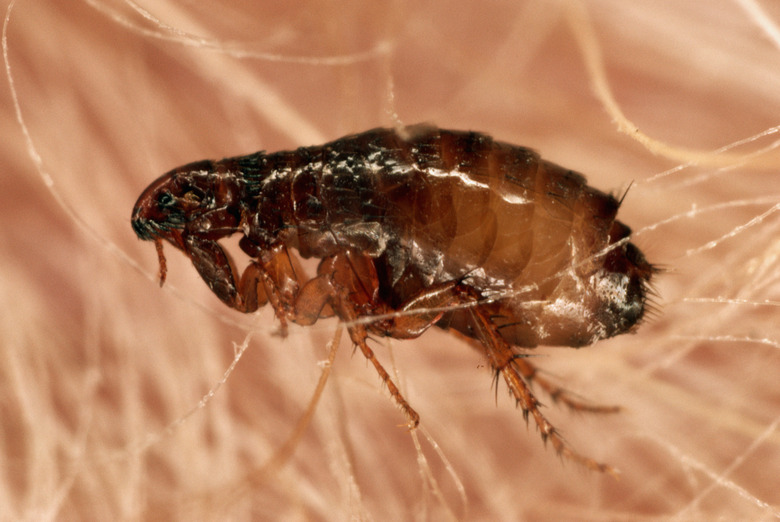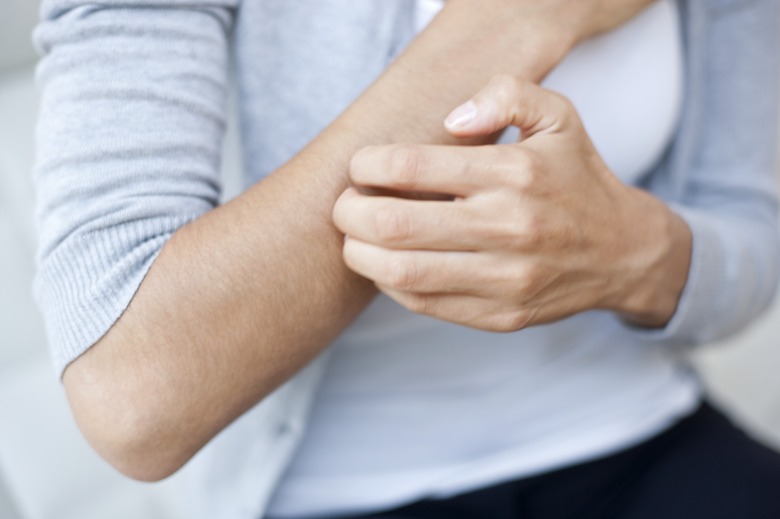All About Fleas — Preventing & Getting Rid Of Fleas On Your Pet & In Your Home
Fleas—they're an inconvenient truth of having pets that go outdoors, and something that likely every pet parent has had to deal with at some point. The best way to handle a flea infestation is through taking preventative measures, like getting your dog or cat on a regimen of flea and tick drops or chews, which nips the problem in the bud before it has a chance to become a problem. Flea baths and collars are methods that are commonly used to kill fleas after they've arrived. For aggressive infestations, it's helpful to understand how pets pick up fleas, how fleas multiply, and the safest and most effective ways for sending them on their way.
The flea lifecycle
The flea lifecycle
Similar to many bugs, most fleas have four life stages, which include egg, larvae, pupa, and adult. Fleas are usually transmitted during the adult stage, which is when they jump onto your pet and burrow into their fur until they reach the skin. Then they lay eggs, which turn into their larvae state, which lasts about 5-20 days. From the larvae stage they turn into pupa, where they wrap themselves into a cocoon before hatching as adults. This cycle can continue essentially forever, so fleas should be treated at first sight before they have a chance to lay eggs.
How to prevent fleas on your pet
How to prevent fleas on your pet
As we stated earlier, prevention is the best way to keep fleas off of your pets and out of your homes. Keeping a clean space will go a long way in removing fleas from your pet, and can deter the egg-hatching process as well. To get rid of fleas in the home, make sure to vacuum carpets and upholstery regularly, wipe down baseboards, and wash and dry all of your pet's bedding, fabric toys, clothing, blankets, and other items they may lay on repeatedly. Use hot water and high heat when possible to wash and try fabrics, and empty your vacuum bag or canister after you've cleaned up a flea-infested area.
In addition to keeping your pet's living space clean, keeping your pet clean is a great way to deter and kill fleas. Many people use flea collars to keep fleas off of their pets, which will work to varying levels of success as it is a super-localized treatment area (around the neck and head.) Always check to make sure a flea collar is safe to use if you have a young kitten or puppy. Topical and systemic preventatives like flea drops or chews work very well to keep fleas off of your pet, and are usually given on a monthly basis. Washing your pet with a medicated flea shampoo for fleas and ticks can remove light flea infestations, and regular shampooing of any kind can help keep bugs, and their eggs, off of your pet—just make sure to use a gentle, conditioning treatment if you plan to bathe them frequently as not to irritate or dry out their skin.
Flea sprays are another topical option for treating fleas, although they usually don't work nearly as well as drops, chews, or even shampoo as it tends to sit on top of a pet's fur. Finally, if you think your pet may have fleas but aren't sure, a flea comb is a great way to check for fleas, and catch and remove them. Because this is such a time-intensive process, however, we don't recommend that a flea comb be your only form of flea control or treatment.
How to choose the best flea treatment for your pet
How to choose the best flea treatment for your pet
There are a number of flea treatments available for dogs and cats, and finding the right one will depend on your pet's lifestyle, medical condition, and skin health.
- Drops and chewables: Medicated flea drops and chews are taken orally and usually once per month. These medications kill existing fleas and their eggs, and prevent new fleas from attaching to your dog or cat. Many are water and bath-proof, and are ideal for pets who spend a lot of time outside in warm climates or high-grass settings.
- Flea collars: Flea collars are also medicated, however, they only send the medication to the immediate area surrounding the collar, which is around your pet's neck and head. Flea collars are a great choice for pets who may go outdoors regularly, but who don't spend long periods of time outside.
- Flea shampoos and sprays: Flea shampoos and sprays are a great of controlling fleas on any pet, regardless of their lifestyle. If you're only going to opt for shampoo or spray, however, it's recommended that you have a pet who spends most or all of their time indoors, where contact with fleas is limited.
Do natural flea remedies really work?
Do natural flea remedies really work?
The short answer to this question, is no, in most cases, home remedies do not work. Using essential oils like peppermint or cedarwood oil to treat fleas on a pet can be very dangerous, as many essential oils are toxic to dogs and cats when they're ingested. Because these oils will sit on your pet's skin and fur, the chances of them licking it off is extremely likely, and since they aren't the best flea control methods to begin with, we recommend you don't put your pet at risk, or waste your time with oils. Apple cider vinegar (ACV) is another popular natural flea remedy suggestion that we can't recommend. While the naturally antibacterial properties of ACV can alleviate irritation on the skin from adult flea bites, the vinegar itself will do nothing to kill or remove fleas or their eggs from your pet or your home.
One natural remedy we can and do recommend, however, is diatomaceous earth, which is a powder made of the fossilized remains of tiny aquatic creatures called diatoms. This works to kill fleas and flea eggs by essentially drying them out from the inside out. Food-grade diatomaceous earth is safe for use around pets, and is an excellent option for killing flea populations, including flea eggs around the home. Dish soap has also been known to effectively suffocate fleas and can be great for washing shoes or other clothing. You can wash your pet with dish soap as well, but we recommended this only in extreme cases as the formula can be very drying.
Fleas and allergies: What you need to know
Fleas and allergies: What you need to know
For most people and animals, flea bites result in an allergic reaction called flea allergy dermatitis. This reaction appears as red, itchy bumps, flaky skin, and even pus-filled bumps, and scabs. In mild flea infestations, these reactions are irritating at worst, but if you let a flea infestation go untreated for too long, symptoms can progress to include hives, rashes, swelling, and even headaches, shortness of breath, and fever in some cases. When pets consistently scratch at flea bites they are at risk of tearing their skin, spreading bacteria or fungus, and even developing anxiety or compulsive behaviors over long periods of time.
If you or your pet have developed a flea allergy, it's recommended that you wash the area thoroughly, and clean your home immediately. You can try using antihistamines to alleviate the itchiness as well. Pets should be bathed and treated with flea medication as soon as possible, and their bedding and clothing should be vacuumed, washed, and dried on high heat to kill any flea eggs and larvae.
Fleas and pregnancy: what you need to know
Fleas and pregnancy: what you need to know
Fleas do carry bacterial diseases, and certain diseases have been shown to transmit from mother to baby. This is obviously not the case every time, but because it is a risk it's recommended that parents take precautions and serious preventative flea control measures if they have a pet in the home.
Fleas and children: What you need to know
Fleas and children: What you need to know
Keeping your child safe from flea exposure and infestation will look the same as keeping you or your pet safe, and the best practices include regular bathing, keeping their clothes and shoes clean, and wash bedding regularly. Additionally, you can reduce their exposure to pets, especially pets you don't know well, and keep your own pets on preventative flea treatments to reduce the risk of exposing your children.
The bottom line
The bottom line
Fleas should always be treated to prevent the growth of flea eggs. This can be done by giving your pet preventative flea medication on a regular basis, be that in the form of topical flea treatments like drops, medicated chews, flea collars, and regular baths. Additionally, keeping your home clean by regularly vacuuming and mopping, and keeping bedding, clothing, and other fabric items washed in hot, soapy water, especially if your pet spends a lot of time on them. Signs of fleas include red bumps and itching, and can include hair loss, dark specks near the skin (otherwise known as flea dirt,) and irritation in areas like the base of the tail in pets.









